Western Digital Expands HGST Helium Drive Lineup with 10TB Ultrastar He10
by Ganesh T S on December 2, 2015 3:01 AM EST- Posted in
- Enterprise
- Storage
- HDDs
- Western Digital
- HGST
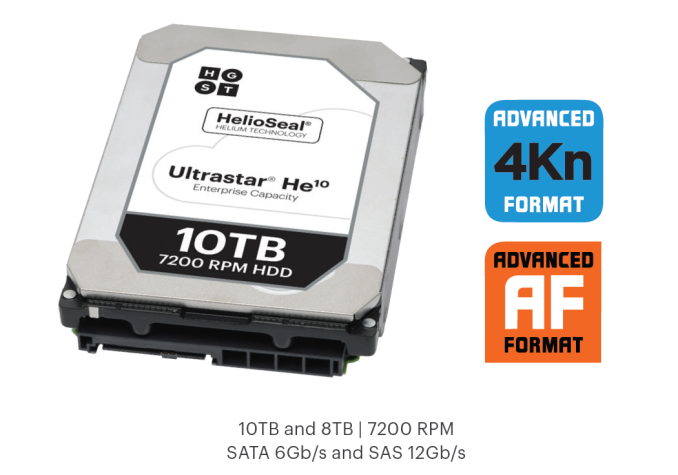
HGST, a Western Digital subsidiary, has been shipping hard drives sealed with helium for a couple of years now. Their helium drives have so far come in two flavors - the Ultrastar He drives using platters with traditional perpendicular magnetic recording (PMR) technology and the Ultrastar Archive Ha drives using platters with shingled magnetic recording (SMR). There are two main patented innovations behind the helium drives, HelioSeal and 7Stac. The former refers to placement of the platters in a hermetically sealed enclosure filled with helium instead of air. The latter refers to packaging of seven platters in the same 1" high form factor of traditional 3.5" drives.
The Ultrastar He6 6TB drive was introduced in November 2013, and this was followed by the He8 8TB drive late last year. In June 2015, the Ultrastar Ha10 SMR drive with HelioSeal technology was introduced. Around the same time, HGST also made it known that more than 1M HelioSeal units had been deployed. 1.33 TB platters have become available in air drives now, and HGST is taking advantage of that in the 10TB Ultrastar He10. The launch of the Ultrastar He10 PMR drive today also brings the news that more than 4M HelioSeal units have been deployed in various datacenters - pointing to the rapid rise in adoption rate of this technology.
We have already seen in our reviews that the helium drives offer the best performance to power ratio and watts per TB metric amongst all the drives in their capacity class. HGST also claim a 2.5M hour MTBF - much higher than traditional enterprise PMR drives. The initial cost of the helium drives have been substantially higher compared to the standard drives of the same capacity, but the TCO (total cost of ownership) metric is highly in favor of these drives - particularly for datacenter customers who need the drives to be active 24x7. HGST's press briefing included a slide that presented the potential TCO benefits that come about due to the increased capacity per rack, lower consumption per rack and lower power consumption per TB of the new He10 drives.
HGST indicated that the ramp in volume should help the initial cost to approach that of the air drives in the near future. For datacenter customers, that would mean an acceleration in obtaining the TCO benefits.
Coming to the core specifications, the Ultrastar He10 will come in both SATA 6Gbps and SAS 12Gbps varieties. The drives have 4KB sectors, though SKUs with 512-byte emulation are also available. Various data security options such as instant secure erase, self-encryption, secure erase and TCG encryption with FIPS are available.
The standard Ultrastar He drive features such as rotational vibration safeguard (for better RV tolerance in multi-drive servers) and the rebuild assist mode (for faster RAID rebuild) are retained. The drives come with a 256MB DRAM buffer.
Hard drives are struggling to reach the 10TB capacity point with traditional PMR technology. While Seagate did announce a few 8TB PMR drives earlier this quarter, it really looks like vendors need to move to some other technology (shingled magnetic recording or heat-assisted magnetic recording (HAMR)) in order to keep the $/TB metric competitive against the upcoming high-capacity SSDs. As of now, helium seems to be the only proven solution causing minimal performance impact and HGST appears to have a strong hold in this particular market segment.


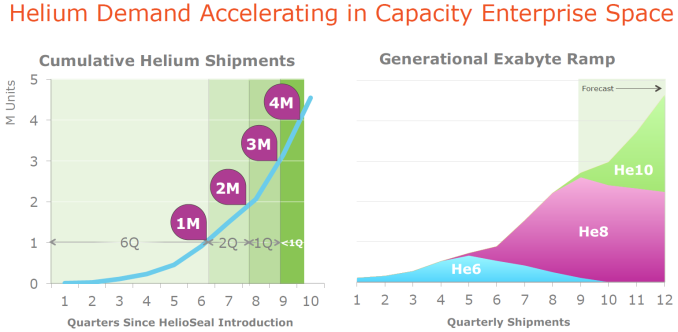
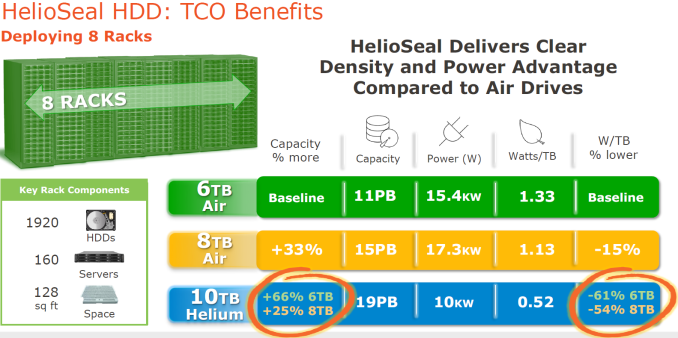
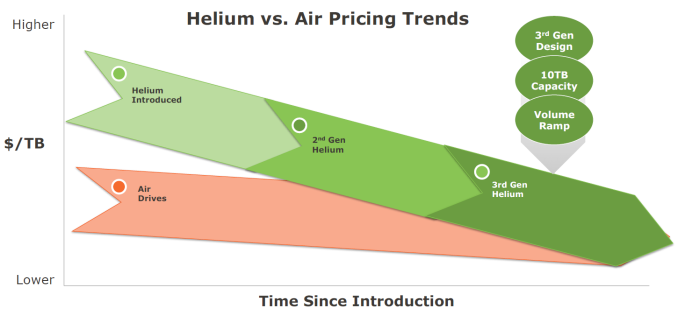
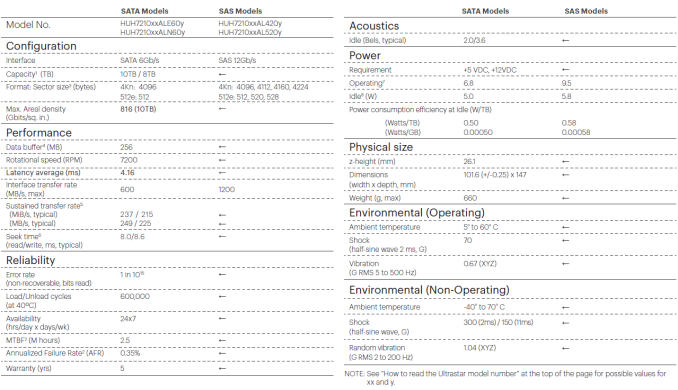
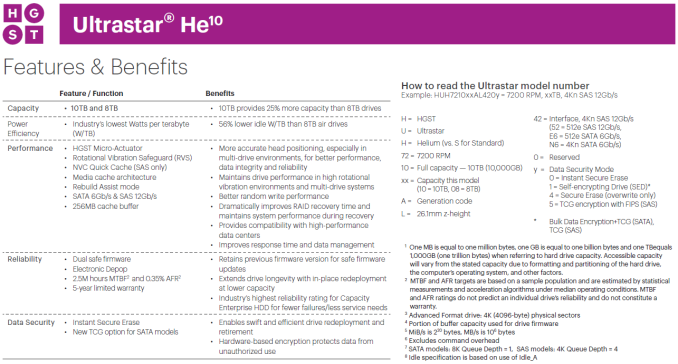








113 Comments
View All Comments
ddriver - Wednesday, December 2, 2015 - link
"Look up Quantum Bigfoot. I'm sure history won't repeat itself."What I am talking about has absolutely nothing to do with that product. I am not talking simply larger plates, I am talking advanced HDD implementation on top of larger plate size. The Bigfoot was big, but ultimately, it was a traditional HDD design, thus even though it offered superior capacity, its access time and sequential performance were compromised because it had a single actuator to service larger area at lower RPM.
Independent multiple heads per platter face will result in dramatically reduced access time and tremendously increased sequential performance even at lower RPM. Independent multiple heads will easily beat even 2.5" 10k RPM drives in terms of latency, and vastly outperform them in terms of throughput. 4 heads per face, 10 platters - that's 80 heads, each capable of a good average 150 mb/sec, as already mentioned, such drive will have an easy time sustaining 5-6 gigabytes per second at below 4 milliseconds access time. Large enough cache buffer of cheap RAM will mask the latency almost entirely, as random frequent accesses will not be written on the media unless the drive is to shut down.
Mechanical storage has barely seen any actual design improvements, the same design has been used for decades, only using occasional technological improvements to scale it down in size, whereas what I talk about is a significant scale up in terms of design. 100% doable, unfortunately too good for the lousy, greedy and lazy industry to go for it.
weissPC - Thursday, December 3, 2015 - link
@ddriver - have you noticed that two 3.5" drive can fit into the foot print of a single 5.25" drive? You want double the capacity? Get two 3.5" drives. You want double the transfer speed? Get two 3.5" drives and RAID 0 them.HDD design is not as simple as a armchair critic envision them to be and is complicated enough as-is, without unnecessarily adding more complicated features that is good to have but in the end will compromise reliability or cost of the end product.
5.25" platter will have much more mechanical flutter towards the edge of the disk it will be difficult to fly the heads there and not crash the heads into the disk surface since the heads are already flying much much closer to the disk than they did back in the Quantum Bigfoot years (there is an exception to this general rule, but that's another story).
Adding another actuator arm to allow multiple heads access on the same platter will double the probability of heads failure making the drive unusable, in addition of consuming drive real estate and cost because you'd need two voice coil motors in two different locations. You can't place VCMs in the same location and have them move two actuator arms independently because they use magnetic fields to function and they will interfere with each other. It's no use having two heads on one surface for backup purposes because a significant portion of head failures is due to the head crashing into the surface of the disk and scraping the surface, having a second head is no much use when you have another head scraping the magnetic materials off the disk and making it unreadable no matter how many heads you have to read the surface.
domboy - Wednesday, December 2, 2015 - link
I have one of the later ~19GB Bigfoot drives... it's been running for years, still works, still in my system as a data drive. Sure it was never the fastest thing, but on the same token it was an unusual technology so it appealed to me. But the Quantum Bigfoot that is not what we're talking about, those are consumer drives. Think something more like Seagate's Elite 5.25" SCSI line. ST446452W for example. Full-height 5.25" 47GB 5400 RPM drives. Sure they were massive in size, but at the time there were probably unmatched in capacity. I bought several used ones off ebay years ago (for really cheap) and they came in hot-swap trays so I expect they must of been in some enterprise storage system. I've had a RAID5 with three of them running 24/7 for probably 10+ years, and who knows how long they were used before that. Probably the most reliable drives I've seen. The sound of them spinning up is awesome... something along the lines of the Time Machine from the 1960 movie. They're awesome.I have no idea if there would be a market for such a drive now, but it's an intriguing idea, and I'd love to see what could be done in a 5.25" form factor with modern technology.
extide - Wednesday, December 2, 2015 - link
I think the fact that you are still using a bigfoot is probably NOT something you should brag about. It's not helping your case...domboy - Wednesday, December 2, 2015 - link
"I think the fact that you are still using a bigfoot is probably NOT something you should brag about. It's not helping your case..."Point is that the Bigfoot is a bad example of a 5.25" as it is a consumer drive, not an enterprise drive, which is the only place a modern 5.25" drive would make sense. But even the later Bigfoot drives at least (can't speak for the whole line, especially the early ones) are not bad drives if put to use in an intelligent manner (i.e. NOT as an OS drive) and this one at least has lasted a long time. Dismiss if you like, but the two examples I posted have proven to me that the form factor can make sense depending on the intended goal or use of the drive. These weren't supposed to be speed demons.
zodiacfml - Wednesday, December 2, 2015 - link
It is because that is where the current market/volume is, for reduction of costs and better margins.nandnandnand - Wednesday, December 2, 2015 - link
You won't get 5.25 inch form factor HDDs, stop talking about it.TeXWiller - Wednesday, December 2, 2015 - link
To think of the amount of 3D-flash that can be put to that 5.25 unit.. Too bad the market would be constricted to pedestal servers and workstations (with a future interconnect for speed), as the current racks would have to be redesigned.ajp_anton - Thursday, December 3, 2015 - link
The fastest mechanical drives are in fact using "2.5 inch" platters (because smaller = faster) inside a 3.5 inch enclosure for stability and protection.But let's see...
Let's assume that the outer track of a 5.3 inch drive moves at half the speed (m/s) compared to 3.5 inch, to keep the centripetal force constant (probably not directly limiting, but to keep vibrations and stability in check).
We can also check that the fastest 2.5'' drives are 15000RPM and the fastest 3.5'' (that actually use big platters) are 7200RPM. So yes, the RPM seems to go down by the square of the platter diameter.
Both approaches result in an RPM of 2000RPM or so.
You need two arms reading simultaneously to reach the same sustained speed, and four arms to reach the same rotational access speed.
Bigger platters means bigger arms with more mass and more distance to cover, but that can be overcome by more powerful, precise and expensive hardware so I'll just ignore that.
Why not just build more arms in the smaller drives we already have? Simply a bigger platter without more arms just gives worse performance in every way.
Why not just put more smaller drives in the same physical space as your proposed bigger one? A big drive needs proportionally more space for just rigidity and to keep everything together. 2.5 inch drives are leading the storage density over 3.5 inch drives, bigger drives would logically be even worse.
Lord of the Bored - Friday, December 4, 2015 - link
It's been done. Aside from the pre-3.5" drives, there was the Quantum Bigfoot. Which had performance problems due to it's size, and attempts to improve performance pushed their price out into the upper-high end of the hard drive market at speeds comparable to slowest 3.5" drives.And hard drive technology hasn't changed a lot since then. Oh, the heads are smaller, the density is better, the platters spin faster, sure. But it's all evolutionary, not revolutionary. You'll hit the same problems now that you did back then.
Two smaller drives is better than one big drive.